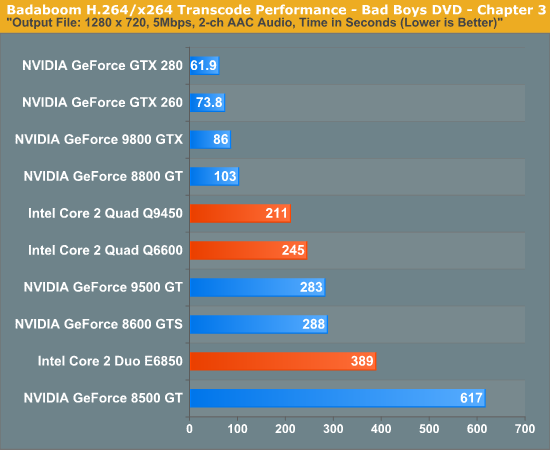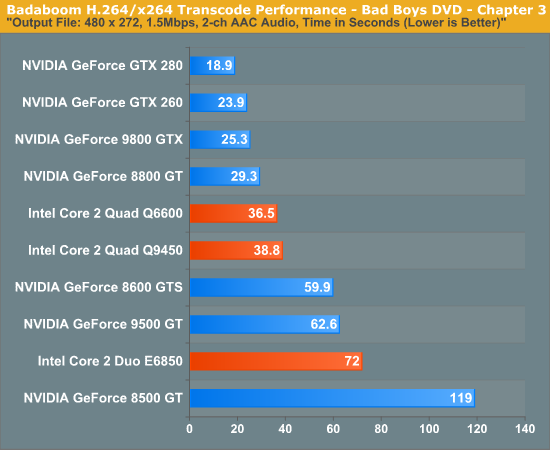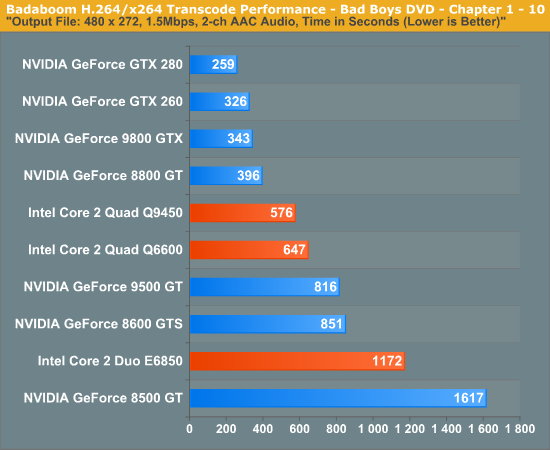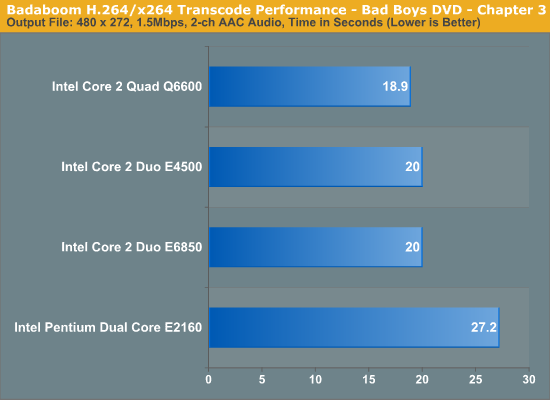Badaboom: A Full Test of Elemental's GPU Accelerated H.264 Transcoder
by Anand Lal Shimpi on August 18, 2008 12:00 AM EST- Posted in
- GPUs
What about Performance?
If you can find a source file that Badaboom will accept and transcode fine, the process is pretty quick.
The first test I ran was to convert Chapter 3 of Bad Boys on DVD to a 5Mbps VBR .mp4 file using the Xbox 360 profile. I upscaled the video to 1280 x 720.
The Core 2 Quad Q6600 completed the test in 245 seconds using the x264 codec, outputting a file that was similar in size and quality to what Badaboom managed (the file was a bit smaller 109MB vs. 116MB and the quality a bit better).

The entry level and midrange 8/9 series GPUs couldn’t actually do much better. The GeForce 9500 GT was actually slower, as were the 8500 GT and the 8600 GTS. The GeForce 8800 GT changed things though, at 103 seconds it encoded the test in less than half the time. NVIDIA’s fastest, the GeForce GTX 280 managed it in just over 60 seconds.
Next I tried outputting a lower resolution file for use on an iPhone, encoded at 1.5Mbps. Despite the default resolution being 480 x 320 the actual output resolution was 480 x 272:

The file outputted was obviously smaller at 35MB and the time to transcode went down significantly. Now our Q6600 took 36.5 seconds and the 8800 GT’s advantage was cut down, it ended up being only about 7 seconds faster (or about 28%). The GTX 280 still pulled ahead, processing the encode in just under 19 seconds.
What this chart shows is that the load on the GPU varies, much as it does in 3D games, depending on what we're doing. Just as higher resolutions tend to be more GPU bound than CPU bound, it would seem that smaller, simpler content at lower transcoding bitrates don't show as big of an advantage. The benefit of GPU accelerated transcoding is clear, but the performance gains will vary depending on the load.
For the final test I repeated the iPhone conversion but instead of only converting Chapter 3 of the DVD I selected the first ten chapters:

In the 5Mbps Xbox 360 test the GeForce GTX 280 ended up being around 3.5x faster than the Core 2 Quad Q9450, in the single-chapter iPhone test the advantage was reduced to 2.1x and here we find that the gap grows slightly to 2.2x but still not quite as high as the original test. It's looking like a range of 2 - 4x the speed of a reasonably fast quad-core CPU is what we can expect from Badaboom if you use NVIDIA's fastest GPU.
If you look at a more reasonably priced GPU, the 9800 GTX ends up being around 2 - 3x faster than the same quad-core CPU. The value of the entry level GPUs isn't that great unless you've got a dual-core CPU, otherwise quad-core chips will be able to encode faster and with better quality.
Next up I wanted to see how fast of a CPU we needed to keep the GeForce GTX 280 fed in its most CPU-bound test, the single-chapter iPhone conversion:

This graph should make NVIDIA pretty happy, you only really need a Core 2 Duo E4500 to keep the GTX 280 fed resulting in performance better than any quad-core Intel CPU can offer. The upside to GPU accelerated video transcode is huge, we just need a better app to deliver it.










38 Comments
View All Comments
pk977 - Thursday, November 6, 2008 - link
Try to test it!will not purchase on that software.
comatose - Sunday, August 31, 2008 - link
"and wireless-n would strain to get even one 720p stream going on a home network. The bandwidth is just not there"Stopped reading there. What a load of bull.
The bandwidth is just not there? Wireless N (the standard) can do up to 600 Mb/s. Most devices support up to 300 Mb/s.
In practice and depending on the environment, you get about 100 Mb/s.
Blu-ray 1080p is maybe 30Mb/s.
It's connectivity, not bandwidth. Besides, most videos you download online or encode yourself are very very unlikely to cross the 6 to 8 Mb/s barrier. That stuff usually only goes on HD media (such as HDTV or Blu-ray).
Even Wireless B could manage that. The trick is streaming the encoded data to where you want it to be watched, and decoding it on that device.
If you're trying to stream raw video data, then of course you can't. It's not meant to be streamed or be stored on anything.
spinportal - Wednesday, August 27, 2008 - link
The missing line that connects all the dots here is a beefy home video media server that transcodes & streams to all your uPnP / mobile-wireless devices, such as the PS3, Wii, XBox360, PSP, iPhone, wifi enabled phones, wifi Archos, laptops, etc.ATI/AMD has dropped the ball. They tossed their home entertainment chip (Xileon - All-In-Wonder) group, so it doesn't appear they want in this space. They aborted the whole transcode deal after X1000. Is Hollywood (and possibly Cable co's) putting on the pressure?
Now if transcoding multiple streams by a media server with Nvidia cards make it easy to feed a whole house load of people / devices wirelessly (draft-n 2.0 with dual-band), imagine the next reaction for big media would be to squash it. They don't want people having huge collections of movies, be it in h.264, XVID, or WMV format on some multi-terabyte home server (there are some nice single purpose living-room jukebox multi-media players like TOMACRO or TVIX that can access wireless file-servers as well, or stand-alone DIVX DVD players with USB connectivity - to a external USB HDD e.g. cheap 500GB+ storage) which can pump video on demand out. It can then inch out into the SlingBox territory where you can serve out to the net; which TVersity, Orb, etc. others can do, but security and lock-down is for the more technically inclined.
The better the transcoder, the better the bit-rate per stream, and then if that target is reached, the transcoder PC can crunch out even more streams. Most media servers are so-so at the 480p level, much less acceptable quality at 720p or dare tread on 1080p content with decent frame rates; and wireless-n would strain to get even one 720p stream going on a home network. The bandwidth is just not there. But what's to stop some indie service to blast Hulu and YouTube like sites with VOD services? Is NetFlix or ComCast or TimeWarner going to be able to put such powerful transcoder cards to task so they can bring real VOD library to the masses? The state of the art today for the consumer is rather toy-like, and I bet Hollywood would rather it stay that way.
Will this bring cable TV to a true a-la-carte vision were VOD servers rule the day where time schedules will end (TV Guides will be revamped to a library style navigation) and can serve up to any wireless device in your house through the STB / (future) hub? Send a upstream request for a PSP client to get a movie, and the cable company downstreams the best specific format; or a SD-TV in the bedroom via an XBox360 for junior, or the HD-TV in the livingroom, all crunched out by the big iron video servers behind the scenes at the cable co. home base using Nvidia cards (or maybe a few 9500Ms in SLI mode and optimized for CUDA to perform local transcode on the STB?) This second scenario is more likely, where control is under Hollywood's management.
If you were able to download raw TS off a DVR to a PC, the genie would be out of the bottle. Take the raw file, crunch to an acceptable compressed codec, then transcode as needed. Why showcase all your DVD boxes on a shelf? Just have a 2 TB+ SAN with a media server and a wireless-g/n gigabit router to serve all your wireless devices (and quite affordable if you know what you're doing but poor quality). The next step is to have complete transcodes done for your device to take with you on the go and out of wired/wireless range without a middleman approach of using a PC to manage the file drop to a media card. Just pick what you want to store locally on the PVP device instead of stream for later. Imagine that done 10x faster. Imagine 10x the amount of devices you can serve in the house. Your bedroom media hub, the living room media hub, the kids XBox360/PS3/Wii, the kids PSP, your Archos for the transmit commute, your iPhone (for those bathroom breaks - you wouldn't drive and watch your iPhone would you?), a laptop or two, an eeePC in the kitchen for streaming the Food Network, etc. Devices are getting smaller, mobile, and multi-function, yet there needs to be that mainstay PC to be the workhorse video transcoder.
Mr Roboto - Thursday, August 21, 2008 - link
The encode times are alright but it still uses about 50%-60% of my idle E8400 as well. Also it's not good for encoding Hi-Def content as it drops a ton of frames that made the few hour long encodes I did recycle bin material. I'm not impressed at all. It seems they should have added some more options and polished it a lot more or not bothered releasing it just yet.That said it seems like the crowd they are aiming for is the people who really don't care about quality (Or can't tell the difference) and just want to play their PSP's and XBox360's and watch some movies on it once in a while. It seems the wrong target IMO as it's the gamers and enthusiasts who own the necessary hardware to see any benefits of Badaboom. Even my 8800GTX didn't seem to chew through encodes like was claimed. In fact It maybe cut the time in half compared to converting a file in Nero, minus the better quality. If they could really get it to work as they bragged about a year ago it would be something.
You can check out the GeForce Power Pack to see for yourselves.
http://www.nvidia.com/content/forcewithin/us/downl...">http://www.nvidia.com/content/forcewithin/us/downl...
Zak - Friday, August 22, 2008 - link
No MKV output? No AC3 passthru? Can you say "half assed"?Z.
The Preacher - Tuesday, August 19, 2008 - link
And what about on-the-fly TV capture into h.264? Let me guess... :)They should rather develop it so it could run on any card with programmable shaders. This is just a waste of time and resource.
foolish501 - Tuesday, August 19, 2008 - link
Downloaded the trial version last week as part of the nvidia driver bundle, and so wanted it to work after reading about it in Maximum PC. Seems extremely picky when it comes to the file types it supports, and would crash so much.Perhaps when it's more stable, and supports more file formats i'll try again
buzzergrain - Tuesday, August 19, 2008 - link
The power consumption numbers are only applicable if the application shuts the computer down after completion.Otherwise idle draw must be subtracted from load draw.
Whichever has a bigger difference between idle and load will therefore be more efficient if running at the same time as web browsing, office work, downloading or other activities such as running the computer as a file server.
yyrkoon - Tuesday, August 19, 2008 - link
Never had a problem with PowerDVD since before the year 2000. Once in a while it will crash, but most of the time that is due to media having flaws(such as DVD disks have deep scratches).HD Video Media is not exactly PC friendly to begin with, and the "DRM specification committee" likes it that way. Maybe we should place some blame on Disney, Intel, Microsoft, Matsushita (Panasonic), Warner Bros., IBM, Toshiba and Sony as well ? Drivers ? Hardware ?
MY OPINION is that since Cyberlink was founded in the mid 90's, and has been writing media based software since at least the late 90's is that: they can not do any worse than this company whom I have never even heard of before now.
Lets not forget that most people who own PowerDVD, got it free with their $36 usd DVD player . . .
Either way, yes this software reviewed is JUNK the way it stands. Hopefully someone will come along and do it right, and MAYBE, the application will even be free :) Something tells me Adobe is paying attention here though . . .
wingless - Monday, August 18, 2008 - link
I want to see a review with Cyberlink's ATI GPGPU implementation of hardware transcoding. Cyberlink will probably have their software code a lot cleaner and usable and the HD4870 should have plenty of horsepower if theoretical peak FLOPS is any measure.